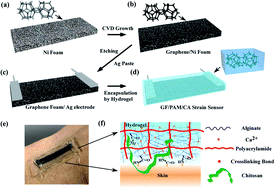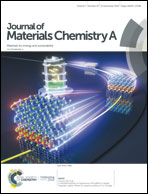A stretchable, conformable, and biocompatible graphene strain sensor based on a structured hydrogel for clinical application†
Abstract
With the increasing demand for wearable and implantable electronics, structured sensors with exceptional performance in sensitivity, stretchability, biocompatibility, and adhesion to the biological surfaces have become essential. Here, we report a novel graphene strain sensor, whose structure contains a carefully selected graphene foam (GF) and polyacrylamide/calcium-alginate (PAM/CA) double network hydrogel coupled with chitosan, can meet the above requirements to the maximum extent. Taking the advantage of the excellent electrical properties of graphene and the mechanical properties of hydrogel, this strain sensor can measure an exceptionally wide range of strain up to 500%, which allows us to monitor and distinguish almost all human body motions, with a gauge factor of ∼1800, which is up to 3 orders of magnitude larger than the 0.1–1000 value reported previously. The device also shows high stability and excellent durability for 1000 cycles. Most importantly, the chitosan-bridge and skin-like elastic modulus of 8–90 kPa allow conformal adhesion between the skin and hydrogel, with the adhesion energy of ∼200 J m−2. Moreover, this structured sensor is highly biocompatible and can be implanted in vivo, and has further potential in clinical applications.



 Please wait while we load your content...
Please wait while we load your content...